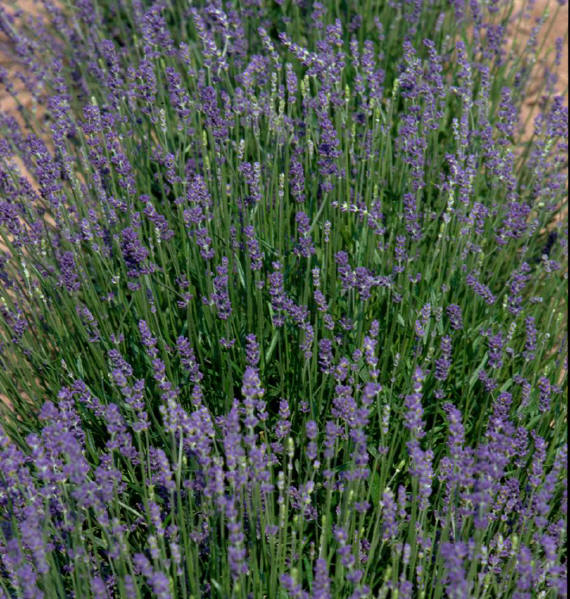Tom Wajda
Adams County Master Gardener
 With some 500 varieties of lavender in the marketplace, even the most
experienced gardener is likely to require some assistance in deciding which one best fits their needs. In addition, there is a great deal of confusion concerning the names of
lavender species.
With some 500 varieties of lavender in the marketplace, even the most
experienced gardener is likely to require some assistance in deciding which one best fits their needs. In addition, there is a great deal of confusion concerning the names of
lavender species.
‘English’ Lavender
‘English’ is a catch-all name for the species Lavandula angustifolia. Most varieties of L. angustifolia are hardy and will survive winter in the
mid-Atlantic with no problems. Examples include ‘Hidcote’, ‘Munstead’, ‘Rebecca Kay’, ‘Cedar Blue’, and ‘Croxton’s Wild’. L. angustifolias tend to grow to a height of 18 to
24 inches with a similar width. They bloom in June with some having a second bloom in late August. The blossoms are about two inches long on stems that are usually 6-8 inches
long. The plants can be started from seeds or cuttings. Starts from cuttings are preferred as the species hybridizes easily and does not necessarily come true from seeds.
The angustifolias are my favorite lavenders. In addition to those listed above, I can recommend ‘Blue Cushion’, ‘Martha Roderick’, ‘Melissa’, and
‘Richard Grey’. ‘Blue Cushion’ and ‘Martha Roderick’ are both smaller than the standard size angustifolia and are excellent as potted plants. ‘Melissa’ has a very nice pink
blossom. ‘Richard Grey’ has a dark purple blossom and silver-grey foliage which results in a lovely plant. However, it requires good drainage and can be somewhat difficult to
grow.
Sometimes, ‘English’ is applied to the species L. x intermedia which are also known as lavandins. This species includes ‘ Provence’, ‘Grosso’, ‘Bleu
des Collines’, and ‘Cathy Blanc’. These varieties tend to grow to a height of 36-42 inches. They produce blooms 2-3 inches long on stems that are 15-18 inches long. Lavandins
bloom in July. L. x intermedias are sterile hybrids and must be propagated from cuttings. Intermedias are usually hardy in the Gettysburg/Hanover region although they often
do not completely ‘green up’ until the end of May.
‘French’ Lavender
‘French’ lavender is not native to France. The scientific name for ‘French’ lavender is L. dentata. The Latin dentata refers to the specie’s toothed
leaves which gives them a fringed appearance. I believe that the term ‘French’ lavender is a corruption of ‘fringed’ lavender. L. dentata is a tender species that will not
survive a frost. However, it can be grown as an annual in the garden or as a potted plant to be brought inside to a sunny window in the fall. Varieties include ‘Grey Fringe’,
‘Green Fringe’, and the variegated ‘Linda Ligon’. They grow to be 16-18 inches high and 12-24 inches wide.
‘Spanish’ Lavender
The scientific name for Spanish lavender is L. stoechas and its origins are in the Mediterranean region. It is not frost hardy; like the dentatas it
can be grown as an annual or in a pot to be brought indoors when cold weather arrives. L. stoechas varieties include ‘Peter’s Pink’, ‘Curly Top’, Madrid Blue’, and
‘Devonshire’. (‘Devonshire’ has a very dark purple blossom and won a blue ribbon at the 2008 Philadelphia Flower Show.)
L. stoechas is a fairly dense plant and should be thinned a little in July to ensure the good air circulation needed to minimize fungus and mildew
attacks. There is considerable variation in the size of the stoechas varieties although most grow to less than two feet high at maturity. The plants can be started from seeds
or cuttings.
Other Tender Varieities
There are many other interesting varieities of lavender; unfortunately, none of them is hardy enough to withstand our winters in the garden, so they
need to be brought indoors before the first frost. For year ’round blossoms, try ‘Goodwin Creek Grey’ or ‘Christiana’. ‘Christiana’ is a prolific bloomer with fern-like
leaves. ‘Goodwin Creek Grey’ can be counted upon to bloom all winter long. Its blossoms and foliage are similar to those of the L. x intermedia.
